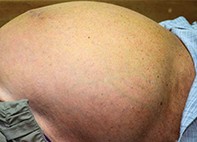Peer Reviewed
Gastroenterology clinic
Managing fluid retention in cirrhosis
Abstract
Fluid retention in cirrhosis, which most often manifests as ascites, is associated with a poor prognosis. All patients who develop ascites should be referred for specialist hepatology input.
Key Points
- Ascites is the most common complication of cirrhosis (Figure 1), affecting 60% of patients over a 10-year period.
- The presence of ascites is a sign of liver failure and is associated with a five-year mortality of 30%.2 Hepatic encephalopathy and variceal haemorrhage are other signs of liver failure.
- Signs of fluid retention that are less often observed in patients with cirrhosis include peripheral oedema and hepatic hydrothorax (5 to 10%) and are almost always observed in association with ascites. Hepatic hydrothorax is usually right-sided, but it can be left-sided or bilateral.
Remember
Purchase the PDF version of this article
Already a subscriber? Login here.

